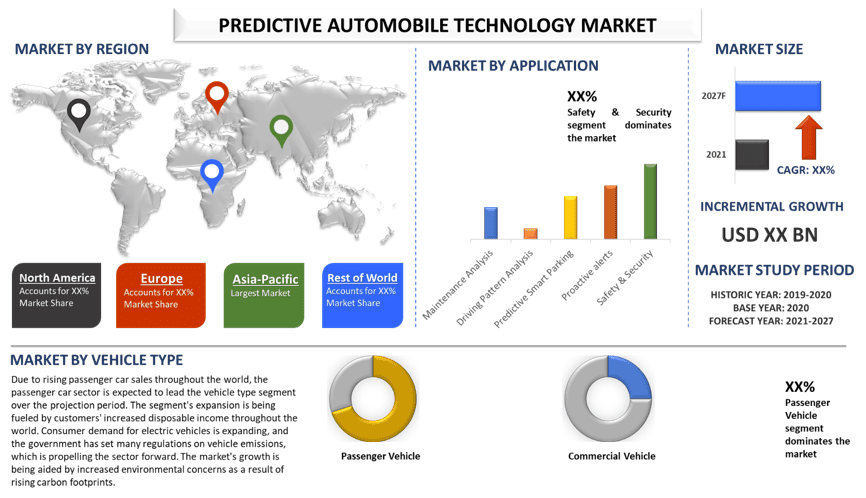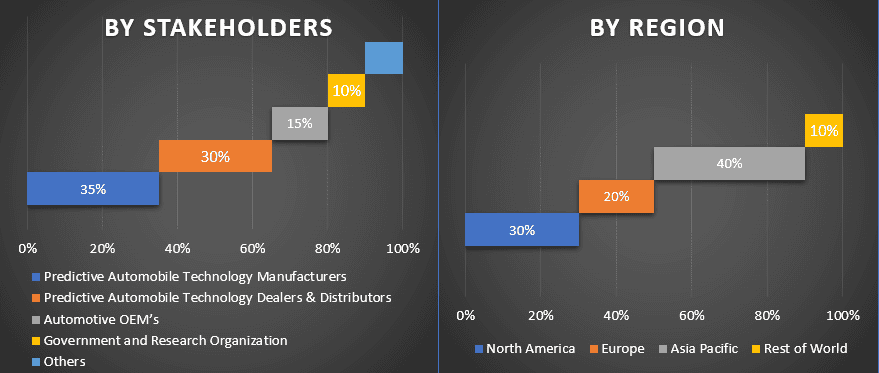- Home
- About Us
- Industry
- Services
- Reading
- Contact Us
Predictive Automobile Technology Market: Current Analysis and Forecast (2021-2027)
Emphasis on Application (Maintenance Analysis, Driving Pattern Analysis, Predictive Smart Parking, Proactive Alerts and Safety & Security); Deployment (On Premise and On Demand); Hardware (ADAS component, On-board diagnostics and Telematics); Vehicle Type (Passenger Vehicle and Commercial Vehicle); Region and Country

Global Predictive Automobile Technology is anticipated to display a CAGR of around ~20% over the forecast period (2021-2027). The cars are fitted with a variety of technologies that detect impediments or other vehicles on the road and take preventative steps such as maintaining the vehicle’s speed and distance from other vehicles. Furthermore, the cars are now connected to one another and communicate information as needed, reducing latency, delay, and effort when traveling. Furthermore, automobiles are getting safer and more secure as a result of new technologies, resulting in increased driver and vehicle safety. Predictive automobile technology is not restricted to automobiles or personal vehicles. The trucking sector is already experiencing a similar trend, fueled by IoT and sensor technologies that allow manufacturers to track data in real-time to ensure vehicle safety, fuel efficiency, and even cargo tracking. Vehicles are now connected to one another and communicate information based on the vehicle’s needs, which helps to reduce latency, delay, and effort when going. Vehicles are getting safer and more secure, resulting in increased driver and vehicle safety. During the forecast period, this is a crucial element that is expected to boost the predictive vehicle technology market.
Insights Presented in the Report
“Amongst Application, Safety & Security segment dominated the market in 2020”
Based on application, the market is segmented into Maintenance Analysis, Driving Pattern Analysis, Predictive Smart Parking, Proactive alerts, and Safety & Security. The Safety & Security segment is expected to grow at a higher CAGR during the forecasted period. Automakers throughout the world are expected to integrate safety and security as an ADAS feature in the next years. These features are primarily designed to aid the driver by providing anticipatory cues. In developed nations, car occupants are expecting similar capabilities in their automobiles. In emerging regions, on the other hand, OEMs are including these features in their automobiles. Government mandates are supporting the expansion of the safety & security segment, since traffic congestion is a major concern in every area, propelling the category’s growth.
“Amongst Deployment, On-Premise segment dominated the market in 2020.”
Based on deployment, the market is segmented into On Premise and On Demand. The On-Premise segment is expected to grow at a higher CAGR during the forecasted period. Over the projected period, the on-premise segment is expected to dominate the market. The growing need for different applications like parking management and pollution analytics is also helping to propel the industry forward. The need for predictive software and services is growing in response to the growing need to improve driver efficiency while also lowering operating costs.
“Amongst Hardware, ADAS segment dominated the market in 2020.”
Based on hardware, the market is segmented into ADAS component, On-board diagnostics, and Telematics. The ADAS component is expected to grow at a higher CAGR during the forecasted period. During the projected period, the ADAS component is expected to be the biggest market. Radar, LiDAR, ultrasonic sensors, and cameras are examples of ADAS components. These sensors detect data and deliver it to a computer for further processing. In many ADAS applications, these sensors can be employed singly or in combination. To improve vehicle safety performance, leading manufacturers across the world are incorporating innovative technologies in passenger and commercial vehicles.
“Amongst Vehicle Type, Passenger segment dominated the market in 2020.”
Based on vehicle type, the market is segmented into Passenger Vehicle and Commercial Vehicle. The Passenger Vehicle segment is expected to grow at a higher CAGR during the forecasted period. Due to rising passenger car sales throughout the world, the passenger car sector is expected to lead the vehicle type segment over the projection period. The segment’s expansion is being fueled by customers’ increased disposable income throughout the world. Consumer demand for electric vehicles is expanding, and the government has set many regulations on vehicle emissions, which is propelling the sector forward. The market’s growth is being aided by increased environmental concerns as a result of rising carbon footprints.
“Asia Pacific represents as the largest market.”
Based on the estimation, during the projection period of 2021-2027, Asia-Pacific is expected to be the fastest-growing market during the forecast period. Vehicle hybridization and electrification, increasing production of electric vehicles, are primary factors driving the demand in the market. China and India, two of the world’s fastest-growing economies, are part of the area. In addition, the Asia Pacific area is the largest market for vehicles, thanks to rising consumer spending power, which has fueled demand for automobiles in the region. In addition, the industry is growing due to rising sales of commercial vehicles and passenger automobiles in the region. The region’s nations are encouraging the integration of commercial telematics into new cars, which will benefit the worldwide commercial telematics industry. To meet the need for modern telematics systems in the subcontinent, many European and North American OEMs are entering the market. As a result, Asia Pacific is predicted to expand somewhat throughout the projection period. Some of the major players operating in the market includes Aptiv PLC, ZF Friedrichshafen AG, Continental AG, Robert Bosch GmbH, Valeo SA, Garrett Motion Inc., Aisin Corporation, Siemens AG, Honeywell International Inc and Magna International Inc. etc.
Reasons to buy this report:
- The study includes market sizing and forecasting analysis validated by authenticated key industry experts
- The report presents a quick review of overall industry performance at one glance
- The report covers an in-depth analysis of prominent industry peers with a primary focus on key business financials, product portfolio, expansion strategies, and recent developments
- Detailed examination of drivers, restraints, key trends, and opportunities prevailing in the industry
- The study comprehensively covers the market across different segments
- Deep dive regional & country-level analysis of the industry
Customization Options:
The Global Predictive Automobile Technology can further be customized as per the requirement or any other market segment. Besides this, UMI understands that you may have your own business needs, hence feel free to connect with us to get a report that completely suits your requirements.
Table of Content
Predictive vehicle technology is a mix of artificial intelligence (AI) and machine learning (ML) that is used to analyze the vehicle owner’s trends and operating patterns in order to improve the vehicle’s safety. Data mining, neural networks, system modeling, and simulation are among the technologies available. Predictive vehicle technology enhances the driving experience by automating settings, such as the infotainment system and application preferences. Since predictive technologies are gaining popularity across all vehicle types for giving the driver comfort and convenience, AI and ML are becoming a vital element of future cars and the auto industry. OEMs are working on IoT and linked device adoption in automobiles that can respond to voice commands. Furthermore, the sensors in the car can alert the owner whether the vehicle needs a mechanic’s attention. Furthermore, the predictive system evaluates the vehicle’s performance based on the vehicle’s condition, miles clocked, and information concerning safety threats associated with car malfunctions. As a result, the data from the system aids in reducing the time it takes to locate and rectify a vehicle defect.
Seek More Details About Research Methodology
The need for predictive automotive technology will be fueled by an increase in demand to enhance automobile performance, as well as an increase in the number of cars on the road. Predictive car technology aids in the early detection of vehicle maintenance difficulties. The market for predictive vehicle technology is being driven by the rising demand for technologically sophisticated automobiles. Vehicles are fitted with a variety of technologies that can detect barriers and cars on the road or in the vicinity of the vehicle and take preventative measures to preserve the vehicle’s speed and distance from other vehicles. Vehicles are now connected to one another and communicate information based on the vehicle’s needs, which helps to reduce latency, delay, and effort when going. Vehicles are getting safer and more secure, resulting in increased driver and vehicle safety. During the forecast period, this is a crucial element that is expected to boost the predictive vehicle technology market.
Analysis of Historical Market Size
Step 1: In-Depth Study of Secondary Sources:
The detailed secondary study was conducted to obtain the historical market size of the Predictive Automobile Technology through company internal sources such as annual reports & financial statements, performance presentations, press releases, etc., and external sources including journals, news & articles, government publications, competitor publications, sector reports, third-party database, and other credible publications.
Step 2: Market Segmentation:
After obtaining the historical market size of the Predictive Automobile Technology, we conducted a detailed secondary analysis to gather historical market insights and share for different segments & sub-segments for major regions. Major segments included in the report are application, deployment, hardware, vehicle type. Further regional & country-level analyses were conducted to evaluate the overall adoption of the Predictive Automobile Technology in the global context.
Step 3: Factor Analysis:
After acquiring the historical market size of different segments and sub-segments, we conducted a detailed factor analysis to estimate the current market size. Further, we conducted factor analysis using dependent and independent variables such as growing government incentives and demand for eco-friendly transportations etc. Historical trends and their year-on-year impact on the market size and share was analyzed. Demand and supply side scenario was also thoroughly studied.
Current Market Size Estimate & Forecast
Current Market Sizing: Based on actionable insights from the above 3 steps, we arrived at the current market size, key players in the Market, and market shares of the segments and company. All the required percentage split, and market breakdowns were determined using the above-mentioned secondary approach and were verified through primary interviews.
Estimation & Forecasting: For market estimation and forecast, weights were assigned to different factors including drivers & trends, restraints, and opportunities available for the stakeholders. After analyzing these factors, relevant forecasting techniques i.e., bottom-up approach was applied to arrive at the market forecast to 2027 for different segments and subsegments across the major regions globally. The research methodology adopted to estimate the market size encompasses:
- The industry’s market size, in terms of value (US$) and the adoption rate of Predictive Automobile Technology across the major markets
- All percentage shares, splits, and breakdowns of market segments and sub-segments
- Key players in the Predictive Automobile Technology in terms of products offered. Also, the growth strategies adopted by these players to compete in the fast-growing market.
Market Size and Share Validation
Primary Research: In-depth interviews were conducted with the Key Opinion Leaders (KOLs) including Top Level Executives (CXO/VPs, Sales Head, Marketing Head, Operational Head, and Regional Head, Country Head, etc.) across major countries. Primary research findings were then summarized, and statistical analysis was performed to prove the stated hypothesis. Inputs from primary research were consolidated with secondary findings, hence turning information into actionable insights.
Split of Primary Participants in Different Regions

Market Engineering
Data triangulation technique was employed to complete the overall market estimation and to arrive at precise statistical numbers of each segment and sub-segment of the Predictive Automobile Technology. Data was split into several segments & sub-segments post studying various parameters and trends in the areas of elevation system, type, product type, structure, and region.
The main objective of the Predictive Automobile Technology Study
The current & future market trends of Predictive Automobile Technology were pinpointed in the study. Investors can gain strategic insights to base their discretion for investments from the qualitative and quantitative analysis performed in the study. Current and future market trends would determine the overall attractiveness of the market at a regional & country level, providing a platform for the industrial participant to exploit the untapped market to benefit as a first-mover advantage. Other quantitative goals of the studies include:
- Analyze the current and forecast market size of Predictive Automobile Technology in terms of value (US$). Also, analyze the current and forecast market size of different segments and sub-segments
- Segments in the study include sub-system and vehicle type
- Defined analysis of the regulatory framework for the Global Predictive Automobile Technology industry
- Analyze the value chain involved with the presence of various intermediaries, along with analyzing customer and competitor behaviors of the industry
- Analyze the current and forecast market size of the Predictive Automobile Technology for the major regions & countries
- Major regions studied in the report include North America (US, Canada, Rest of North America), Europe (Germany, United Kingdom, France, Italy, Rest of Europe), Asia Pacific (China, Japan, India, South Korea, Rest of Asia-Pacific), and Rest of World
- Company profiles of the Predictive Automobile Technology players and the growth strategies adopted by them to sustain in the fast-growing market
- Deep dive regional & country level analysis of the industry
Related Reports
Customers who bought this item also bought










